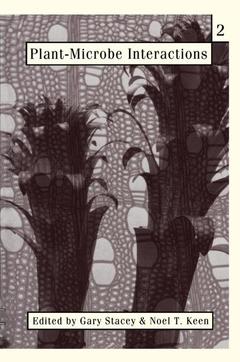Description
Plant-microbe Interactions 2, 1997
Volume 2
Authors: Stacey Gary, Keen Noel T.
Language: English
Subject for Plant-microbe Interactions 2:
Keywords
Expression; Pathogen; bacteria; gene expression; nitrogen; physiology; plant; regulation; synthesis
Approximative price 158.24 €
In Print (Delivery period: 15 days).
Add to cart
Publication date: 09-2012
228 p. · 15.2x22.9 cm · Paperback
228 p. · 15.2x22.9 cm · Paperback
Description
/li>Contents
/li>Comment
/li>
Plant-Microbe Interactions, Volume 2 Volume 1 of this series has made its appearance and dealt forcefully with impor tant current topics in the field of plant-microbe interactions. We believe that the quality of those chapters was high and should serve as a focal point for the state of the art as well as an enduring reference. Volume 2 builds upon these accom plishments. Chapter 1 discusses the fascinating lipo-chitin signal molecules from Rhizo bium, aspects regarding their biosynthesis, and the basis for host specificity. These molecules are a cardinal example of how microorganisms influence plant development and stimulate speculation that they have identified a previously un known aspect of plant hormone activity. Chapter 2 continues the discussion of Rhizobium by considering the trafficking of carbon and nitrogen in nodules. Al though the ostensible advantage of nodules to plants is the fixation of atmos pheric nitrogen, the actual process involved in supplying reduced nitrogen to the plant host is complex.
Avirulence determinants in viruses, Jim Culver, University of Maryland; Virulence mechanisms in plant pathogens, Tim Denny, University of Georgia; Regulation of nodulin gene expression, Frans de Bruijin, Michigan State University; Biosynthesis and host-specificity of Nod factors, Ben Lugtenberg, Clusius Laboratory, Leiden; Avirulence genes, Janet Leach and Frank White, Kansas State University; Role of rhizosphere microorganisms in bioremediation, Barbara Walton, Oak Ridge National Laboratory; Physiology of nitrogen fixing nodules, Alan Collmer, Cornell University; The hrp genes of plant pathogenic bacteria, Jeff Dangl, Max-Delbruck Laboratory, Cologne; Geminiviruses, Judith Brown, University of Arizona; Agrobacterium, Eugene Nester, University of Washington
The second edition of this highly successful text covers all aspects of plant-microbe interactions. It reflects the current state of knowledge of plant-microbe relationships and provides convenient summaries of the latest research in this fast-advancing discipline. It covers all aspects of plant-microbe interactions including benificial plant symbioses, plant pathology, plant genetics, molecular biology, agronomy, ecology and phytochemistry.
© 2024 LAVOISIER S.A.S.
These books may interest you

Plant-Microbe Interactions 158.24 €



